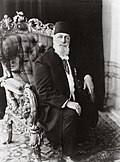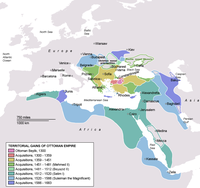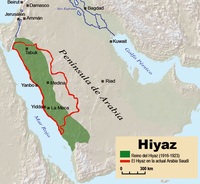List of Caliphs
From Wikipedia, the free encyclopedia
| Caliph of the Faithful | |
|---|---|
| Former political post | |
 |
|

Abdülmecid II
|
|
| First officeholder | Abu Bakr |
| Last officeholder | Abdülmecid II |
| Style | His Imperial Majesty[1] |
| Official residence | Dolmabahçe Palace |
| Appointer | Hereditary |
| Office began | 8 June 632 |
| Office ended | 3 March 1924 |
|
|
This article provides insufficient context for those unfamiliar with the subject. (June 2011) |
Contents
- 1 Rashidun Caliphs (632–661)
- 2 Umayyad Caliphs (661–750/1031)
- 3 Abd Allah ibn al-Zubayr (684-692)
- 4 Abbasid Caliphs (750–1258/1517)
- 5 Other Caliphates (909–1269)
- 6 Caliphs under the Ottoman Empire (1517–1922)
- 7 Caliph under the Republic of Turkey (1922–1924)
- 8 Sharifian Caliphate (1924)
- 9 Ahmadi Caliphate (1908–present)
- 10 See also
- 11 References
- 12 Bibliography
Rashidun Caliphs (632–661)
The first four are accepted by Sunni Muslims as rightly guided caliphs (Khalifas)[2][3]- Abu Bakr - 632–634
- Umar ibn al-Khattab - 634–644
- Uthman ibn Affan - 644–656
- Ali ibn Abi Talib - 656–661
- Hasan ibn Ali - 661 (Relinquished the caliphate to Muawiyah I). [4]
Umayyad Caliphs (661–750/1031)
Caliphs of Damascus (661–750)
[2][5]- Muawiyah I - 661–680
- Yazid I - 680–683
- Muawiyah II - 683–684
- Marwan I - 684–685
- Abd al-Malik - 685–705
- Al-Walid I - 705–715
- Sulayman - 715–717
- Umar II - 717–720
- Yazid II - 720–724
- Hisham - 724–743
- Al-Walid II - 743–744
- Yazid III - 744
- Ibrahim - 744
- Marwan II - 744–750
Emirs of Córdoba (756–929)
- Abd ar-Rahman I - 756–788
- Hisham I - 788–796
- al-Hakam I - 796–822
- Abd ar-Rahman II - 822–852
- Muhammad I - 852–886
- al-Mundhir - 886–888
- Abdallah ibn Muhammad - 888–912
- Abd-ar-Rahman III - 912–929 (Declared himself Caliph)
Caliphs of Córdoba (929–1031)
(Not universally accepted; actual authority confined to Spain and parts of Maghreb)[6][7]- Abd-ar-Rahman III - 929–961
- Al-Hakam II - 961–976
- Hisham II al-Hakam - 976–1009
- Muhammad II - 1009
- Sulayman ibn al-Hakam - 1009–1010
- Hisham II al-Hakam, restored - 1010–1013
- Sulayman ibn al-Hakam, restored - 1013–1016
- Abd ar-Rahman IV - 1021–1022
- Abd ar-Rahman V - 1022–1023
- Muhammad III - 1023–1024
- Hisham III - 1027–1031
Abd Allah ibn al-Zubayr (684-692)
| This section is empty. You can help by adding to it. (April 2013) |
Abbasid Caliphs (750–1258/1517)
Caliphs of Baghdad (750–1258)
(Not accepted by the Muslim dominions in the Iberian peninsula and parts of North Africa).[8][9]- As-Saffah - 750–754 (Founder of the Abbasid dynasty).
- Al-Mansur - 754–775
- Al-Mahdi - 775–785
- Al-Hadi - 785–786
- Harun al-Rashid - 786–809
- Al-Amin - 809–813
- Al-Ma'mun - 813–833
- Al-Mu'tasim - 833–842
- Al-Wathiq - 842–847
- Al-Mutawakkil - 847–861
- Al-Muntasir - 861–862
- Al-Musta'in - 862–866
- Al-Mu'tazz - 866–869
- Al-Muhtadi - 869–870
- Al-Mu'tamid - 870–892
- Al-Mu'tadid - 892–902
- Al-Muktafi - 902–908
- Al-Muqtadir - 908–932
- Al-Qahir - 932–934
- Ar-Radi - 934–940
- Al-Muttaqi - 940–944
- Al-Mustakfi - 944–946
- Al-Muti - 946–974
- At-Ta'i - 974–991
- Al-Qadir - 991–1031
- Al-Qa'im - 1031–1075
- Al-Muqtadi - 1075–1094
- Al-Mustazhir - 1094–1118
- Al-Mustarshid - 1118–1135
- Ar-Rashid - 1135–1136
- Al-Muqtafi - 1136–1160
- Al-Mustanjid - 1160–1170
- Al-Mustadi - 1170–1180
- An-Nasir - 1180–1225
- Az-Zahir - 1225–1226
- Al-Mustansir - 1226–1242
- Al-Musta'sim - 1242–1258 (last Abbasid Caliph at Baghdad)
Caliphs of Cairo (1261–1517)
(The Cairo Abbasids were largely ceremonial Caliphs under the patronage of the Mamluk Sultanate that existed after the takeover of the Ayyubid Caliphate)[10][11]- Al-Mustansir II - 1261–1262
- Al-Hakim I - 1262–1302
- Al-Mustakfi I - 1302–1340
- Al-Hakim II - 1341–1352
- Al-Mu'tadid I - 1352–1362
- Al-Mutawakkil I - 1362–1383
- Al-Wathiq II - 1383–1386
- Al-Mu'tasim - 1386–1389
- Al-Mutawakkil I (restored) - 1389–1406
- Al-Musta'in - 1406–1414
- Al-Mu'tadid II - 1414–1441
- Al-Mustakfi II - 1441–1451
- Al-Qa'im - 1451–1455
- Al-Mustanjid - 1455–1479
- Al-Mutawakkil II - 1479–1497
- Al-Mustamsik - 1497–1508
- Al-Mutawakkil III - 1508–1517 (surrendered the title to Selim I, below)
Other Caliphates (909–1269)
Fatimid Caliphs (909–1171)
Main article: List of caliphs of the Fatimid Caliphate
(The Fatimids belonged to the Ismaili branch of Shia Islam and hence are not recognized by the majority of Sunnis, whether subjects in their dominions, or from neighboring states).[12][13]- Al-Mahdi Billah - 909–934 (Founder of the Fatimid dynasty).
- Al-Qa'im Bi-Amrillah - 934–946
- Al-Mansur Billah - 946–953
- Al-Muizz Lideenillah - 953–975 (Egypt is conquered during his reign).
- Al-Aziz Billah - 975–996
- Al-Hakim bi-Amr Allah - 996–1021
- Ali az-Zahir - 1021–1036
- Al-Mustansir Billah - 1036–1094
- Al-Musta'li - 1094–1101 (Quarrels over his succession led to the Nizari split).
- Al-Amir - 1101–1130 (The Fatimid rulers of Egypt after him are not recognized as Imams by Mustaali Taiyabi Ismailis).
- al-Hafiz - 1130–1149
- al-Zafir - 1149–1154
- Al-Faiz - 1154–1160
- Al-Azid - 1160–1171
Almohad Caliphs (1145–1269)
(Not widely accepted, actual dominions were parts of North Africa and Iberia)[14][15]- Abd al-Mu'min - 1145–1163
- Abu Yaqub Yusuf I - 1163–1184
- Yaqub al-Mansur - 1184–1199
- Muhammad an-Nasir - 1199–1213
- Abu Ya'qub Yusuf II - 1213–1224
- Abd al-Wahid I - 1224
- Abdallah al-Adil 1224–1227
- Yahya - 1227–1235
- Idris I - 1227–1232
- Abdul-Wahid II - 1232–1242
- Ali - 1242–1248
- Umar - 1248–1266
- Idris II - 1266–1269
Caliphs under the Ottoman Empire (1517–1922)
Originally the secular, conquering dynasty was just entitled Sultan, soon it started accumulating titles assumed from subjected peoples.[16][17]- Selim I - 1517–1520 (induced al-Mutawakkil III to formally surrender the Caliphate after defeating the Mamluk Sultanate in 1517; actively used the title)
- Suleiman the Magnificent - 1520–1566
- Selim II - 1566–1574
- Murad III - 1574–1595
- Mehmed (Muhammed) III - 1595–1603
- Ahmed I - 1603–1617
- Mustafa I - 1617–1618
- Osman II - 1618–1622
- Mustafa I, restored - 1622–1623
- Murad IV - 1623–1640
- Ibrahim I - 1640–1648
- Mehmed (Muhammed) IV - 1648–1687
- Suleiman II - 1687–1691
- Ahmed II - 1691–1695
- Mustafa II - 1695–1703
- Ahmed III - 1703–1730
- Mahmud I - 1730–1754
- Osman III - 1754–1757
- Mustafa III - 1757–1774
- Abdul Hamid I - 1774–1789
- Selim III - 1789–1807
- Mustafa IV - 1807–1808
- Mahmud II - 1808–1839
- Abdülmecid I - 1839–1861
- Abdülaziz - 1861–1876
- Murad V - 1876
- Abdul Hamid II - 1876–1909 (actively used title of Caliph)
- Mehmed (Muhammed) V - 1909–1918
- Mehmed (Muhammed) VI - 1918–1922
Caliph under the Republic of Turkey (1922–1924)
- Abdülmecid II - 1922–1924 (ceremonial Caliph under the patronage of the Republic of Turkey and its President Gazi Mustafa Kemal Pasha (Atatürk))
- Grand National Assembly of Turkey - March 3, 1924
After the dissolution of the Office of the Caliphate, the Grand National Assembly of Turkey founded the Presidency of Religious Affairs as the new highest Islamic religious authority in the country.
Sharifian Caliphate (1924)
Main article: Sharifian Caliphate
A last attempt at restoring the caliphal office and style with ecumenical recognition was made by al-Husayn ibn `Ali al-Hashimi, King of Hejaz and Sharif of Mecca, who assumed both on 11 March 1924 and held them until 3 October 1924, when he passed the kingship to his son `Ali ibn al-Husayn al-Hashimi, who did not adopt the caliphal office and style.[18]Ahmadi Caliphate (1908–present)
Main article: Khalifatul Masih
See also
- Caliph
- Caliphate
- Emir
- History of Islam
- Khilafah (Caliphate)
- Hazrat Muhammad
- Shah
- Shaikh ul-Islam
- Shi'a Islam
- Succession to Muhammad
- Sultan
- Sunni Islam
References
- Jump up ^ Bence-Jones, Mark (1980). "The Turkish Monarchy" (snippet view). In Montgomery-Massingberd, Hugh. Burke's Royal Families of the World. Volume II: Africa & the Middle East. London: Burke's Peerage. p. 236. ISBN 978-0-85011-029-6. OCLC 18496936. Retrieved 2010-07-14. "Though his position as a Caliph with no power beholden to a republican and secularist regime was full of anomaly, Abdülmecid II was styled "Imperial Majesty" and surrounded by a considerable degree of regal pomp"
- ^ Jump up to: a b Lane-Poole 2004, p. 9
- Jump up ^ Bosworth 2004, p. 1
- Jump up ^ According to a hadith of the Islamic prophet Muhammad the Rashidun Caliphate will last thirty years after him. The total period of the first four Caliphs amounts to twenty nine years and six months. It is there for now recognized by scholars that Hasan ibn Ali's six months of Caliphate completes the thirty year prediction and hence he is also among the Rashidun Caliph.[citation needed]
- Jump up ^ Bosworth 2004, p. 4
- Jump up ^ Lane-Poole 2004, p. 21
- Jump up ^ Bosworth 2004, p. 11
- Jump up ^ Lane-Poole 2004, pp. 12–13
- Jump up ^ Bosworth 2004, pp. 6–7
- Jump up ^ Bosworth 2004, p. 7
- Jump up ^ Houtsma & Wensinck 1993, p. 3
- Jump up ^ Lane-Poole 2004, p. 71
- Jump up ^ Bosworth 2004, p. 63
- Jump up ^ Lane-Poole 2004, p. 47
- Jump up ^ Bosworth 2004, p. 39
- Jump up ^ Lane-Poole 2004, p. 195
- Jump up ^ Bosworth 2004, pp. 239–240
- Jump up ^ Bosworth 2004, p. 118
Bibliography
- Bosworth, Clifford Edmund (2004) [First published 1996]. The New Islamic Dynasties: A Chronological and Genealogical Manual. New Edinburgh Islamic Surveys (2nd ed.). Edinburgh University Press. ISBN 978-0-7486-2137-8. OCLC 56639413.
- Houtsma, M. Th.; Wensinck, A. J. (1993). E.J. Brill's First Encyclopaedia of Islam 1913–1936 (Reprint). Volume IX. Leiden: BRILL. ISBN 978-90-04-09796-4.
- Lane-Poole, Stanley (1894). The Mohammedan Dynasties: Chronological and Genealogical Tables with Historical Introductions. Westminster: Archibald Constable and Company. OCLC 1199708.
|
||








No comments:
Post a Comment